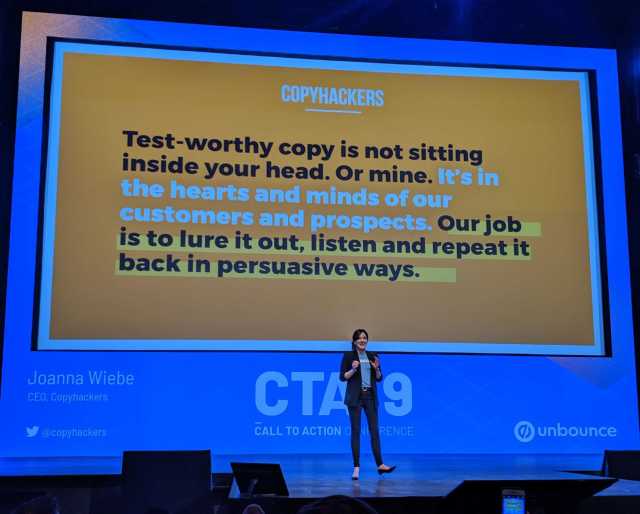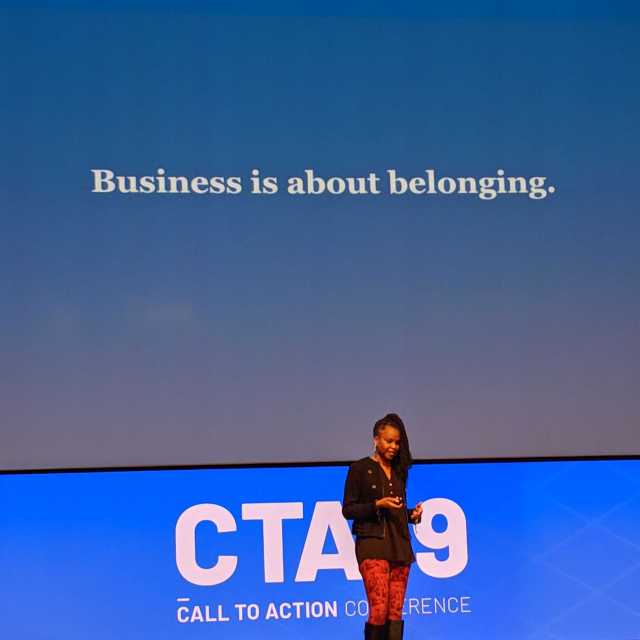Let's have a chat about taking your digital marketing to the next level
Last week, I had the pleasure of attending Unbounce’s 2019 Call-to-Action conference in Vancouver, BC. Unbounce consistently creates a wonderful learning experience for 1000+ marketers who attend. Their attention to detail and the diverse approaches of the speakers always make for a great holistic marketing event… not to mention the food trucks and live band karaoke bring it to a whole new level!
It has been a week since the conference wrapped and there are some one-liners of truth that are ringing in my head that I want to share with you today. These are statements or questions that I’m still thinking about; With my memory, if anything sticks in my brain, it’s a sign that it is something worth sharing!

“Is your copy ‘breakthrough or bust’?”
Joanna Wiebe from Copyhackers is someone I have admired from afar for years and did she ever deliver on stage. Her tips all revolved around listening to the members of your audience and then putting their words through copywriting formulas or best practices (like ABC – Always Be Clear), and then repeating it back, but in persuasive ways.
The best part of Joanna’s talk was that it was incredibly actionable AND she gave tips I’d never thought of regarding where we should be listening. Some examples are Amazon book reviews for books on similar topics, Google reviews for competitors, founder interviews (the original users) and so much more. In the last week, we’ve used her tips to create test-worthy copy around our Local SEO offering and I’m so excited to see what a difference it makes to us here at Snaptech!
Ultimately, you want your copy to feel “breakthrough or bust”. Are you saying something in a different way, and ask yourself if it is ultimately speaking to everyone you need it to? Do you get the feeling that this is different, and if it goes wrong, it could go very wrong? If so, you’re probably on the right track. A big thank you to Joanna, who you can find on Twitter @copyhackers, for giving me and my team a whole new way to think about writing for our audience.
“What are you doing that the customer doesn’t expect you to do?”
Flavilla Fongang is engaging and exceptional on stage. She is a neuromarketing expert who distills the brain into easy-to-digest pieces for us to understand. From her talk, I learned that in order to truly raise your marketing IQ, you need to be doing what your consumers don’t expect you to do.
Humans aren’t rational. We are run by our reptilian brain (the primitive part that we don’t really have control over) and emotion drives our decision making. The only way to stand apart from the crowd is to differentiate what we do from others and demonstrate the tangible gain users will have from working with us.
My biggest takeaway from Flavilla was that not only is neuromarketing cool, but we need to tap into the reptilian brain in order to have a customer stop and listen. Tapping into that reptilian brain requires visuals that engage us and emotions that drive us.
You can find Flavilla on Twitter at @flavillafongang.
“If you don’t plan your time, you can’t claim distraction!”
One of my favourite talks from the conference had nothing to do with marketing at all. It was instead about distraction and how it can keep us from doing what we need to do. As individuals whose output at work is about finding novel solutions to complex problems, we need time to think in order to do our jobs properly. Yet, we often claim to not have the time.
As Nir Eyal pointed out, if we aren’t planning our time, how can we be distracted? This led me to consider how the big blocks of white space on my calendar often become checking emails, going to meetings, playing cornhole or foosball and generally flitting from one task to the other.
With the help of Nir’s talk, I’ve blocked my time out each morning (when I’m most focused) to dedicate to specifically being focused on one thing at a time. I wrote my monthly marketing reports in one morning, instead of five days. I’d say the tips from Nir were invaluable.
The main takeaway here is that distraction is nothing new – we’ve been distracted for centuries. We simply use technology as an excuse. Block your time, pick what you are going to be focused on, and then go for it. We’re also introducing “don’t bother me” signs at the office – so that others in deep concentration mode can really buckle down and get to work.
Nir used engaging real-world examples to demonstrate the way we get distracted, why we get distracted, and how to combat it. Want to learn more from Nir? Follow him @nireyal on Twitter (and check out his book Indistractable)!
“Humans aren’t data points”
Sarah Gurbach of Seer Interactive, a fellow Shine Bootcamp alumna, took to the stage to talk about how we can treat consumers like they are correlations, or charts, or data points. The line “Humans aren’t data points” has stuck with me over the past seven days. Sarah’s point was that you have to TALK to your customers. You can’t treat them as predictable, and you should be asking them for feedback.
So often we settle into a pattern of letting algorithms, heat maps, click charts and data dictate how we make changes without actually asking for feedback from the people we’re trying to connect with. I’ve been thinking about this sentence since the conference, and it’s the one I want to put on a shirt or put on the wall, or possibly even get a tattoo of, all while emphasizing it with my team over and over again.
There are so many missed opportunities from not talking to your clients, customers are people, empathy is a choice, and a little bit of understanding can go a long way in improving your marketing. Check out Sarah on Twitter @thegurbs for more!

“The Niche Customer is becoming the Lead Customer”
My favourite talk from the week and one I know I will watch over and over again was by Sonia Thompson. Sonia talked about belonging, from all perspectives, and asked us whether or not our businesses were unintentionally sending signals about belonging to those in our audience. She educated us about homophily, which is the tendency for humans to have non-negative ties with people who are similar to themselves. We talked about how this affects our marketing. Who in the room is making your targeted personas, and are they actually members of the audience you want to attract?
Additionally, are you unintentionally excluding anybody by not emphasizing that they belong in your marketing? Sonia also encouraged us to look at all the ways we are different, not only in ethnicity and gender, education level and household income but also with food allergies and dietary choices, left and right-handedness and more.
The line that Sonia said that sticks with me the most and the one from the conference I’ve been thinking about non-stop is “the niche customer is becoming the lead customer”. As someone who doesn’t drink alcohol and has food allergies, I thought hard about this, and it’s true. My friends look to me to make dinner and food choices. My preferences, as the niche customer in my group, are what dictate what the entire group does.
Sonia’s question to us was whether or not we are sending signals of belonging to those niche customers, and its something I encourage every business to really address. If you want to learn more from Sonia, and I highly encourage that, you can find her @soniaethompson on Twitter.
Until Next Year!
I know that my team will be implementing these takeaways and more throughout the coming months, and I’m exceptionally grateful to Unbounce for having me and hosting such an incredible conference. They say if you leave a conference with one takeaway then it was worth it, but I left with several and I can’t wait to see what they come up with next year!

